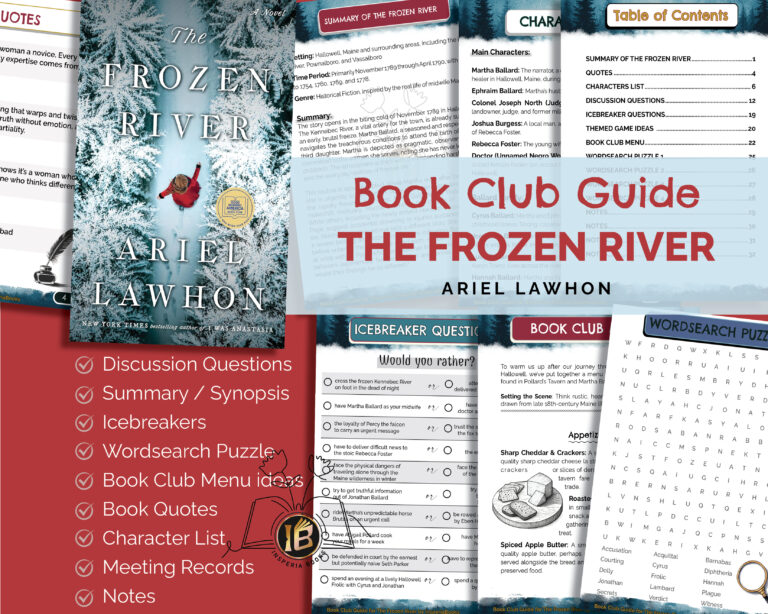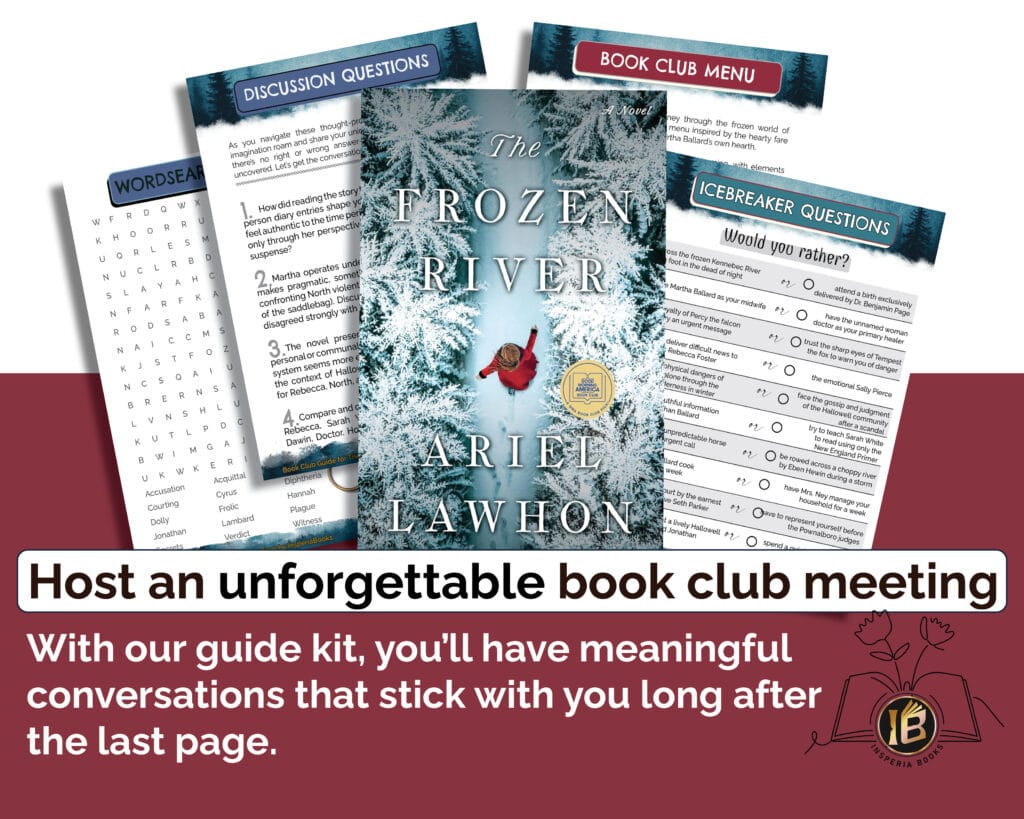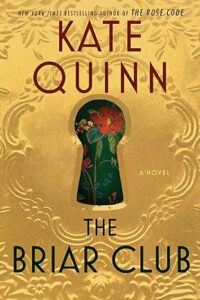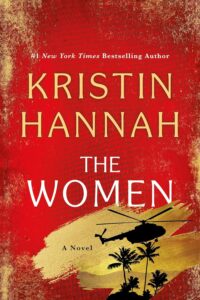Table of Contents

First Published:December 5, 2023
Genre: Historical Fiction, Mystery, Legal Drama
Time Period: Late 1789 through Spring 1790
Setting / Location: Primarily Hallowell, Maine, a small town on the Kennebec River
Pages: 432
⚠️ Spoiler Alert! If you intend to read this book after perusing this guide and don’t want spoilers, you might want to bookmark this for later. Otherwise, carry on, juicy insights await!
Summary of The Frozen River
The Frozen River by Ariel Lawhon is a historical novel inspired by a true story bringing the diary of midwife Martha Ballard to life against the backdrop of a harsh Maine winter. Her keen observations guide us through the daily struggles and quiet strengths of frontier life, until the discovery of a frozen body pulls her into a dangerous web of community secrets and injustice.
The story opens in the biting cold of November 1789 in Hallowell, Maine. The Kennebec River, a vital artery for the town, is already succumbing to an early, brutal freeze. Martha Ballard, a seasoned and respected midwife, navigates the treacherous conditions to attend the birth of Betsy Clark’s third daughter. Martha is depicted as pragmatic, observant, and deeply committed to the women she serves, noting she has never lost a mother in childbirth. The atmosphere is thick with the impending harshness of winter and the everyday realities of frontier life.
This routine is soon disrupted. While Martha rests after the Clark delivery, she is urgently summoned. A body has been discovered, entombed in the rapidly freezing Kennebec River. Gathered at Pollard’s Tavern, the makeshift mortuary, Martha examines the corpse of Joshua Burgess. While others, including the newly arrived, Harvard-educated Dr. Benjamin Page, suggest accidental drowning or injuries sustained amidst the river ice, Martha’s experienced eye tells a different story. She finds evidence of a severe beating and distinct rope burns indicating Burgess was hanged before entering the water. Her conclusion: murder. This instantly sets her at odds with Dr. Page, who dismisses her findings, representing the clash between experienced female intuition and formal male authority. Why would their findings be so different?
The discovery of Burgess’s body is fraught with underlying tension because he, along with the influential local judge and landowner Colonel Joseph North, stands accused of raping Rebecca Foster months earlier, in August 1789. Martha had attended Rebecca in the aftermath, documenting her injuries and listening to her harrowing account in the privacy of her midwife’s diary – a meticulous record she keeps of her days, deliveries, and the town’s happenings. Martha staunchly believes Rebecca, but the community is divided, with many siding with the powerful men.
As the “Year of the Long Winter” tightens its grip, isolating Hallowell, Martha must navigate not only the elements but also the simmering suspicions and social divisions. Dr. Page actively works to undermine her authority, while Colonel North subtly threatens her, aware of her potential testimony. Martha’s investigation into Burgess’s death intertwines with her commitment to supporting Rebecca and seeking justice, all while managing her large family and midwifery duties. Her husband, Ephraim, is her steadfast support, though her children present their own challenges: oldest son Cyrus becomes a suspect due to a public fight with Burgess shortly before his death; son Jonathan grapples with his own secrets, including an entanglement with Sally Pierce (the Fosters’ former maid) that results in an illegitimate child; daughters Hannah and Dolly navigate their own courtships with local boys Moses Pollard and the intriguing court officer Barnabas Lambard.
Key events unfold through Martha’s dated journal entries and recollections: the tense courtroom session where Dr. Page contradicts Martha’s findings about Burgess; Sally Pierce’s damaging (and false) testimony accusing Rebecca’s husband, Isaac, based on a misheard statement; Martha’s discovery of letters in Burgess’s saddlebag revealing North planned to steal the Ballards’ land and mill rights, likely using the property to buy Burgess’s silence or complicity regarding the rape; a terrifying confrontation where North attacks Martha at the Ballard mill, leading her to defend herself violently, leaving him severely wounded with his own knife, “Revenge.”
The mystery of Burgess’s death finds its resolution not with North or Cyrus, but elsewhere. Martha observes Sam Dawin (one of the men who found Burgess’s body) carrying a distinctive strip of lace – identical to the one Rebecca described Burgess tearing from her shift. This leads to a quiet confession: Burgess had also assaulted Sam’s fiancée, May Kimble, on the night of the Frolic. Consumed by rage and disillusioned with the legal system after North’s acquittal seemed likely, Sam, aided by Martha’s son Jonathan, hunted Burgess down, beat him, and hanged him. Was this a different kind of justice?
The novel culminates in the Supreme Judicial Court trial of Joseph North for the attempted rape of Rebecca Foster, held in Pownalboro. Rebecca, now heavily pregnant with the child conceived from the assault and unwilling to face her community again, does not attend. Martha presents her diary as crucial evidence, corroborating the timing and details of Rebecca’s deposition. Despite Martha’s testimony and the physical evidence of the pregnancy, North’s lawyer argues lack of direct witnesses to the crime itself. Joseph North is ultimately acquitted of the charge.
Though legal justice fails Rebecca, North does not escape unscathed, bearing the permanent physical consequences of Martha’s defense at the mill. As the harsh winter finally breaks and the Kennebec River thaws, Martha continues her work. The final scene shows Tempest, the silver fox Martha encountered earlier – a creature embodying wildness and perhaps a different kind of knowing – watching over the valley with her new kits, suggesting the persistence of life and perhaps a more natural, untamed form of order returning to Hallowell.
List of Characters in The Frozen River
This list contains the main characters, including the Ballard family as mentioned in the Frozen River. While it contains a long list of characters, it is not exhaustive. To get the full list of all the characters in the book, you can purchase The Frozen River by Ariel Lawhon Book Club Guide.
Main Characters:
- Martha Ballard: The narrator, a dedicated and experienced midwife and healer in Hallowell, Maine, during the late 18th century.
- Ephraim Ballard: Martha’s husband, a mill owner and surveyor.
- Colonel Joseph North (Judge North): An influential and wealthy landowner, judge, and former military officer in Hallowell.
- Joshua Burgess: A local man, also accused alongside North in the rape of Rebecca Foster.
- Rebecca Foster: The young wife of the local pastor, Isaac Foster.
- Doctor (Unnamed Negro Woman Doctor): A mysterious and highly skilled female healer (an accoucheuse or midwife) who periodically visits Hallowell.
The Ballard Family:
- Cyrus Ballard: Martha and Ephraim’s oldest son (33 years old). Mute since childhood illness. Strong, capable mill worker, protective of his sisters.
- Jonathan Ballard: Martha and Ephraim’s second son (26 years old). Works with his father, involved in river trade.
- Lucy Ballard Town: Martha and Ephraim’s oldest daughter. Married (to Aaron Town), lives across the river near Fort Western, has several children.
- Hannah Ballard: Martha and Ephraim’s older surviving daughter.
- Dolly Ballard (Dorothy): Martha and Ephraim’s younger surviving daughter (17 years old).
- Ephraim Ballard, Jr. (Young Ephraim): Martha and Ephraim’s youngest son (11 years old).
- Martha Ballard (daughter): Deceased daughter, died at age eight during a diphtheria outbreak years ago.
- Triphene Ballard: Deceased daughter, died at age five during the same outbreak.
- Dorothy Ballard: Deceased daughter, died at age two during the same outbreak.
Book Club Discussion Questions For The Frozen River
The questions have been curated to spark meaningful discussions in your book club meeting.
- Martha operates under a strong moral code but also makes pragmatic, sometimes morally grey, choices (like confronting North violently or initially concealing the origin of the saddlebag). Discuss instances where you agreed or disagreed strongly with her decisions and why.
- Compare and contrast the female characters – Martha, Rebecca, Sarah White, Lidia North, Sally Pierce, May Dawin, Doctor. How do they each navigate the significant limitations and expectations placed on women in their time and community?
- Secrets permeate the story – Rebecca’s initial silence, Jonathan’s actions, Sam’s burden, North’s schemes. What motivates these secrets, and what are their ultimate consequences for the individuals and the town?
- The Kennebec River is central to the setting and title. How does the state of the river (frozen, thawing, flooding) function symbolically or influence the plot and the characters’ emotional states throughout the story?
- While both Joshua Burgess and Joseph North commit heinous acts, how does the novel differentiate their characters, motivations, and ultimate fates? Does the portrayal feel satisfying or complicated?
If you loved these book club questions and want more, we have created a Comprehensive Book Club Guide Kit for The Frozen River by Ariel Lawhon. This guide provide everything you need to host a lively and engaging book club meeting, including:
- Over 30 thought-provoking discussion questions in printable PDF format that will help you explore the novel’s themes.
- Fun icebreaker questions to get your discussion started.
- Challenging word search puzzles based on the novel’s characters and events.
- Delicious food and drink ideas inspired by the novel.
- Insightful book quotes with explanations to help you understand the novel’s deeper meaning.
- Meeting record templates to take notes and keep track of your discussions, and so much more!
These guides are perfect for book clubs of all sizes and experience levels. They are also a great resource for individual readers who want to deepen their understanding of the novel.
10 Trivia Facts About Martha Ballard and other Historical Figures and Events in The Frozen River
One thing that makes me love reading historical fiction books is the fact that it makes me learn more about history. After reading The Frozen River by Ariel Lawhon, I decided to find out some more information about the incredible midwife that was Martha Ballard as well as other historical figures and events mentioned in the Frozen River. Here are some things I discovered:
Martha Ballard (1735-1812): Was a real midwife in Hallowell (part of Kennebec County, District of Maine, then Massachusetts) who delivered over 800 babies in her career. She famously recorded never losing a mother in childbirth, though infant mortality was still high.
The Diary: Martha’s diary is real and incredibly detailed, though more of a daybook than an introspective journal. It covers 27 years. Historian Laurel Thatcher Ulrich won a Pulitzer Prize for her book A Midwife’s Tale: The Life of Martha Ballard, Based on Her Diary, 1785-1812, which analyzed it extensively.
Joseph North (1739-1825): Was a real, prominent figure in the Kennebec region – a judge, surveyor, landowner, and military officer (Colonel). He was accused by Rebecca Foster.
Rebecca Foster: Was a real person, wife of Rev. Isaac Foster. She accused North, Burgess, and Elijah Davis of rape in August 1789. The details of multiple assaults over a week, as mentioned in the Author’s Note, are horrifyingly accurate to the historical record. She did not attend the trial in July 1790.
Joshua Burgess: Was a real person and one of the accused. He disappears from Martha’s diary entries around December 1789. His actual fate is unknown; he was not historically known to be murdered.
Elijah Davis: The third man accused by Rebecca Foster, who was omitted from the novel.
The Trial: Joseph North’s historical trial took place later than in the book, in July 1790. He was acquitted.
The Ballard Children: Martha and Ephraim had nine children. Six survived to adulthood: Cyrus, Lucy, Jonathan, Hannah, Dolly, and Ephraim Jr. Three daughters (Martha, Triphene, Dorothy) died young in a diphtheria epidemic in 1769, a real tragedy for the family. Cyrus historically never married or left home. Jonathan did have an illegitimate child with Sally Pierce (born Feb 1791). Hannah did marry Moses Pollard (1792). Dolly did marry Barnabas Lambard (1795).
Year of the Long Winter: While Lawhon uses the term for 1789-90, the actual “Year of the Long Winter” known for its extreme cold and frozen river in Hallowell was historically 1784-85 (the river freezing Nov 25 and remaining solid until late April).
Currency: Martha’s diary does mention payments in both pounds/shillings and dollars, reflecting the transitional currency period. She often received goods/services as payment.
My Review and Rating
As someone who enjoys getting lost in historical fiction, the premise of The Frozen River – a midwife in 18th-century Maine solving a mystery – immediately caught my eye. I had heard whispers about the real Martha Ballard, maybe from Laurel Thatcher Ulrich’s A Midwife’s Tale, but exploring her world through Ariel Lawhon’s story was a completely different experience.
From the opening pages, I felt completely drawn into Martha’s life in Hallowell. Lawhon does a phenomenal job bringing the harshness and beauty of that long winter in 1789 Maine to life – I could almost feel the biting cold off the Kennebec River. Reading from Martha’s perspective, framed like her actual diary entries, made her feel incredibly real and immediate. Her voice is so strong – pragmatic, observant, fiercely dedicated to her work and the women she served, yet showing glimpses of deep emotion and frustration with the injustices she witnessed. The details about midwifery at the time were fascinating, and her relationship with her husband, Ephraim, was a grounding warmth amidst the cold and conflict. The central mysteries – who killed Joshua Burgess, and would Rebecca Foster ever see justice – kept me turning pages late into the night.
Now, I will say, the pacing, true to a diary perhaps, sometimes felt a little uneven. While I appreciated the detail of Martha’s daily life and deliveries, there were moments, especially with the sheer number of births mentioned, where it felt a bit repetitive. And initially, keeping track of the large cast of Hallowell residents took some concentration – so many similar names! I also appreciated the Author’s Note at the end explaining the liberties taken with the historical record; knowing where fact ended and fiction began added another layer to think about, especially regarding the Burgess murder mystery, which apparently wasn’t part of the real diary.
But honestly, those are minor points for me. What truly stood out was Martha herself. She’s such a formidable character – intelligent, compassionate, principled, and incredibly brave, especially when facing down powerful men like Judge North or the dismissive Dr. Page. Her quiet determination to uncover the truth, despite the risks and the constraints placed upon women in her time, was inspiring. Following the twists and turns of the rape accusation against North and the underlying murder kept me guessing, and the way Lawhon wove together the different threads of the story felt masterfully done. The resolution, especially regarding Burgess’s death, genuinely surprised me.
So, the bottom line? The Frozen River was a rich, atmospheric, and deeply engaging read for me. It’s a story full of suspense, heartbreak, and quiet strength, anchored by an unforgettable main character. It offers a vivid look into a challenging historical period and the often-overlooked lives of women within it.
Would I read it again? Absolutely. It’s a story that sticks with you. I would rate this 4.5 stars.
Frequently Asked Questions
Is The Frozen River based on a true story
Yes, The Frozen River is inspired by a true story and real historical figures, but it is a work of historical fiction, not a direct biography or factual retelling. The central character, Martha Ballard, was a real midwife who lived in Hallowell, Maine, and kept an extensive diary from 1785 to 1812. This diary is a significant historical document. The core event of Rebecca Foster accusing Colonel Joseph North and Captain Joshua Burgess (and historically, a third man named Elijah Davis) of rape in 1789 is also historically documented in Martha’s diary and court records. Many of the supporting characters (Ephraim Ballard, their children, the Pollards, the Sewalls, etc.) correspond to real people Martha interacted with. The setting and the harsh realities of the “long winter” are grounded in historical context.
The author, Ariel Lawhon, explicitly states in the Author’s Note that she took significant liberties. The most substantial fictional element is the murder of Joshua Burgess and Martha’s investigation into it. Historically, Burgess simply disappears from the record; Lawhon used this ambiguity to create the central mystery.
So, while rooted in the real life and diary of Martha Ballard and a documented rape case, the plot surrounding the murder and many character motivations are fictionalized for the novel.
What is The Frozen River about
The Frozen River is a historical fiction novel inspired by the real diary of Martha Ballard, an 18th-century midwife in Hallowell, Maine. Set during a harsh winter in 1789, the story begins when Martha is called to examine the body of a man found frozen in the Kennebec River. While authorities suspect an accident, Martha believes he was murdered, intertwining her investigation with a controversial rape accusation against the deceased and a powerful local judge, forcing her to navigate community secrets, legal battles, and the limitations placed on women in post-Revolutionary America.
About The Author - Ariel Lawhon
Ariel Lawhon is a critically acclaimed New York Times bestselling author celebrated for her immersive historical fiction. She possesses a talent for bringing often overlooked figures and moments from the past vividly to life, frequently focusing on strong, complex women navigating extraordinary circumstances. Before taking readers to 18th-century Maine in The Frozen River, Lawhon garnered significant praise for several other compelling novels.
Her widely popular book, Code Name: Hélène, detailed the incredible true story of Nancy Wake, a socialite turned decorated spy and leader in the French Resistance during WWII. She also tackled the enduring mystery surrounding the woman who claimed to be the surviving Grand Duchess Anastasia Romanov in I Was Anastasia. In Flight of Dreams, Lawhon imagined the lives and secrets aboard the Hindenburg leading up to its infamous disaster, while her debut, The Wife, the Maid, and the Mistress, offered a fictionalized perspective on the real-life disappearance of Judge Joseph Crater in 1930.
Additionally, she co-authored When We Had Wings, exploring the experiences of nurses in the Philippines during World War II. Across her body of work, Lawhon consistently blends meticulous research with engaging storytelling, often infusing elements of mystery and suspense into her rich historical settings.
Was this post helpful?
We’d love to hear from you : )
Wondering What to Read Next?
Discover your next book read tailored to suit you! No more long book recommendation quizzes that make your eyes go dizzy.
Our book recommendation engine knows exactly what book will captivate you next.
Simply tell us what you’ve loved reading, and well unveil a perfect match for your reading pleasure.
You will absolutely love it!





